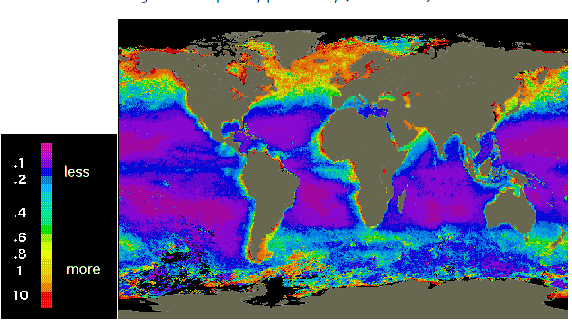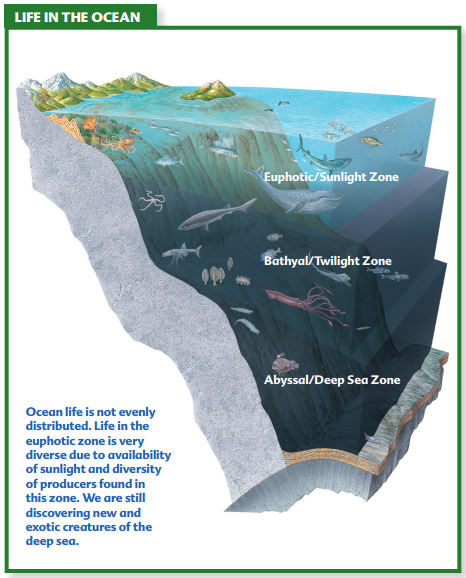Chapter 11: Marine Biomes
Global Distribution
Phytoplanktons are the major primary producers in Ocean, and the rest of marine animals rely on the primary productions for energy sources. Therefore, we can map the global distributions of marine life based on the distribution of chlorophyll and primary productions, see figures below 1:

High primary productivity regions clustered in coastal regions where nutrients come from the lands, east side of ocean basins as well as polar regions where upwelling occur, and equatorial regions where surface water diverge and nutrient-rich deep water move upwards 1. These are also likely to be the regions with most marine organisms.
To “assess and explain the diversity, distribution and abundance of life in the oceans”2, the Census of Marine Life was formed as a global network with researchers in more than 80 nations2, and the newly published map highlighting discoveries of ocean life in a decade’s investigation could be found at www.comlmaps.org/oceanlifemap…tion-abundance 3.
Distribution In the Ocean
As with the global distribution of marine organisms, lives in the ocean are not evenly distributed throughout the ocean either, and are mostly controlled by the abiotic factors of marine environment such as temperature, salinity and light availability 4. Therefore, oceans could be divided into three general zones which are euphotoic, twilight and deep sea zones4.
- Euphotic Zone
- Twilight Zone
- Deep Sea Zone

The Deep Sea
The majority of biodiversity in the ocean in found in the photic zone where light permeates the water column making photosynthesis possible; however, even in the deep sea where little to no light is available, life has found a way. The deep sea is vastly different than shallow waters and riddled with physiological challenges. The water is frigid and pressure is immense in the dark depths. Because no photosynthesis occurs, there are very little nutrients in the water so meals are often few and far between. Animals that live in the deep sea have adapted to these challenging conditions stupendously. Many organisms have evolved bioluminescence, or the ability to create their own light. This is a very useful ability for attracting prey or finding a mate in the dark. In addition to bioluminescence, many deep sea predatory fish have evolved extremely large jaws, teeth, and eyes for finding and capturing prey while reducing other structures such as skeletons, muscles, and swim bladders to conserve energy and resist the effects of pressure. Since food is scarce in the deep sea, many of its inhabitants have extremely slow metabolisms so that they are capable of going up to a year without food in some cases. This host of adaptations has allowed life to not only survive, but to thrive in one of the most inhospitable environments on the planet.
The Euphotic zone is characterized by its many diverse ocean life. The ocean life in the Euphotic zone include sharks, jellyfish, sea turtles, coral, and zooplankton. The reason why there are so many various life in this zone is because of its access to sunlight. Direct sunlight causes photosynthesis, which allows many opportunities for life. The zone below this is the Bathyal zone, which is also known as the Twilight zone, because sunlight does not reach the Bathyal zone. The Bathyal zone is 1000 – 4000 meters below the surface of the ocean. Since there is no sunlight, a lot of the life in this zone don’t have eyes. The marine life that do have life include squids, whales, and octopuses. It is difficult for fish to live in this zone, so they usually stay in the Euphotic zone. Lastly, the deepest ocean zone is the Abyssal zone. In this zone, the water pressure is so high that the marine life that live here need to be able to withstand the pressure. The marine life that live here aren’t very typical. They are most commonly described as “abnormal”, or sometimes even “scary”. An example of marine life that lives in this zone is called the “Black Swallower”, and it is a fish that has the capability of swallowing other fish that are bigger than its own body size.
Sources
- oceansjsu.com/105d/exped_ecosystems/8.html
- http://www.comlmaps.org/
- www.comlmaps.org/oceanlifemap…tion-abundance
- education.nationalgeographic….n-chapter3.pdf
By Hill et al. (University of California, Davis), used under a CC-BY-NC-SA 4.0 international license. Download this book for free at https://geo.libretexts.org/Bookshelves/Oceanography/Book%3A_Oceanography_(Hill)

